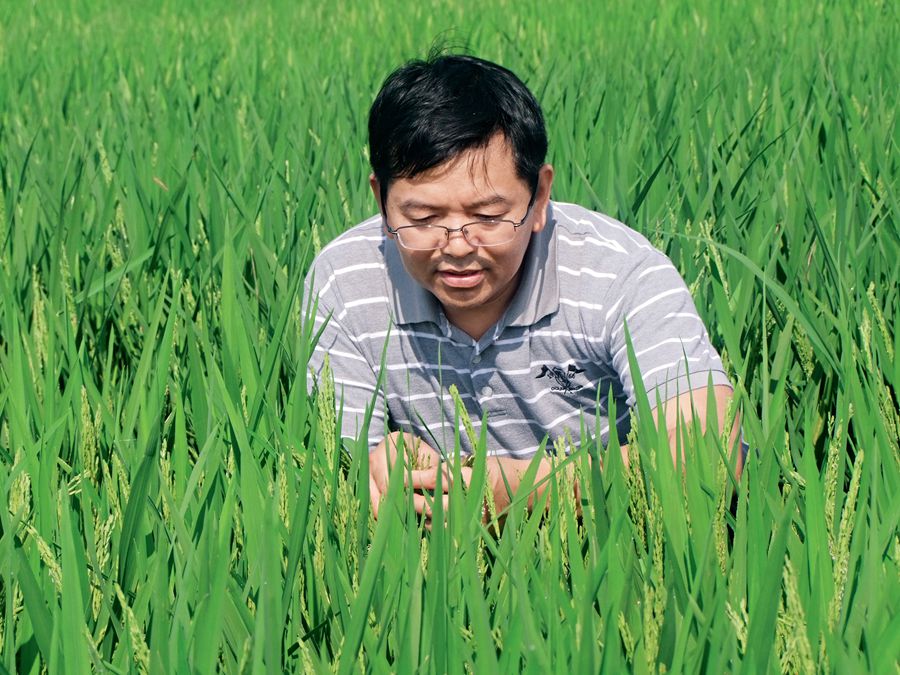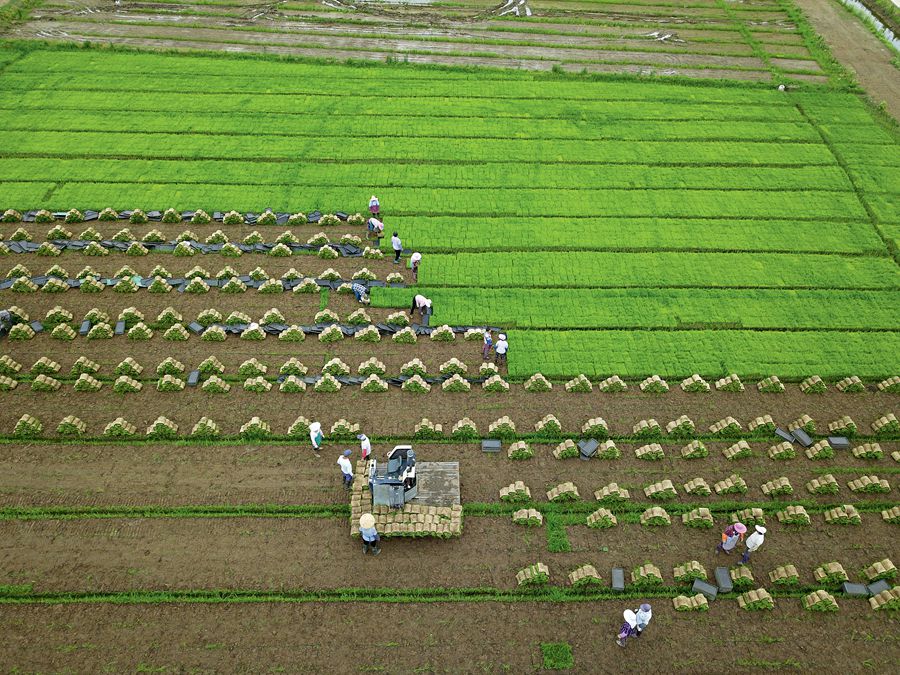SEEDS are the matrix of agriculture. The seed is to grain production what chips are to the technology industry. Sustainable development of the seed industry is vital to food safety.
Since its founding in 1949, the People’s Republic of China (PRC) has paid particular attention to the seed industry in developing agriculture. Notably after the reform and opening-up policy was launched in 1978, China achieved marked progress in crop growing and grain production, feeding 22 percent of the world’s population with only seven percent of the total arable land.
Breakthroughs in Breeding
After the PRC was founded, seeds produced under then limited breeding technology resulted in low-yield and poor-quality crops that were vulnerable to diseases.
Paddy rice is the dominating grain in China, with its output accounting for some 40 percent of national grain outputs. In the 1950s, the country mainly grew the variety characterized by high plant height measuring around 1.5 meters. Thus lodging (bending over of the stems of grain crops near ground level) was common, especially with a high input of water and fertilizers. To address the problem, Huang Yaoxiang, an agricultural expert, and his team developed a new variety of rice with a shorter height ranging from 80 to 90 centimeters. The new variety boasts lower fertilizer needs and better lodging resistance, with the yield per hectare increasing from 3,750 kilograms to 5,250 kilograms.

In 2018, Yang Yuanzhu leads a team to select rice varieties in a rice breeding base of Longping Hi-Tech in Lingshui, Hainan Province.
“It marked a major breakthrough in the world’s history of rice breeding, and was hailed as the first green revolution in the global agricultural history,” said Wan Jianmin, vice president of the Chinese Academy of Agricultural Sciences (CAAS) and an academician of the Chinese Academy of Engineering.
The second green revolution is about the change from conventional rice to hybrid rice. Starting from the 1960s, experts, with Yuan Longping as the leading light, began studies into developing hybrid rice and achieved success in 1973. The new variety of hybrid rice was promoted nationwide in 1976, raising output per hectare from more than 5,250 kilograms to over 6,000 kilograms.
The success didn’t stop them from pursuing a higher goal. In 1994, the research team developed a new method, simplifying the breeding procedure and enhancing the yield to more than 6,750 kilograms per hectare, according to Yang Yuanzhu, head of rice research at the Yuan Longping Hi-Tech Agriculture Co., Ltd. More importantly, the promotion of hybrid rice prompted the birth of super hybrid rice varieties. The target of 15,000-kilogram yield per hectare has been achieved. At the moment, the yield figure in China is 1.71 times the global average.
Apart from improving output, new rice varieties have better performance in resisting disease and pests. Diseases like rice strip virus and bacterial leaf blight can be contained totally with proprietary rice varieties, said Wan Jianmin.
Wheat is the staple of China’s grain crop next to rice, especially in north China. According to He Zhonghu, a researcher with the Institute of Crop Sciences at the CAAS, domestic wheat breeding went through three stages, with the focus on disease resistance, yield stabilization, and early maturing, shifting to shorter plants, lodging resistance and high yield, and finally to higher quality and yield. “After the PRC was founded, the yield of wheat per unit area has exploded eight-fold. And the wheat-yielding region experienced eight to nine large-scale variety upgrades, contributing significantly to the improvement of unit yields and overall output,” said He.
China also achieved marked progress in breeding studies on maize, sorghum, potato, and other grain crops. Thousands of new improved varieties have been developed, enabling many large-scale seed upgrades. Following this achievement, China manages to feed its population of nearly 1.4 billion with its proprietary seeds.
Innovation Is Key
In the 1980s, farmers in north China’s Hebei Province had to water the wheat five to six times in each planting season. About 4,500 cubic meters of water were needed for each hectare. Now, they only water the crop twice, using 1,500 cubic meters of water each time. He Zhonghu attributed the progress to breeding technologies assisted by technologies like molecular markers and computational information.

Yang Yuanzhu conducts research in the field.
China has rolled out a myriad of measures to spur innovation of these technologies. Through reform of the benefit mechanism for academic results, research professionals have shown enthusiasm for innovation, and research achievements have been commercialized at a faster speed, said Yu Xinrong, vice minister of the Ministry of Agriculture and Rural Affairs. The government has advanced reform of delegating approval powers to lower administrative departments and canceled licensing and approval processes for many matters. It has also overhauled the management system of grain varieties and opened a green corridor for related issues. The efforts aim at stimulating the vitality and ability to innovate among enterprises.
As early as in 2011, the State Council released a guideline, encouraging businesses to establish an independent research and development (R&D) system and intensify commerce-oriented research into breeding technologies. As of now, more than 80 percent of grain varieties have been developed by enterprises, which now have become the main driving force for innovation.
As a forerunner in the seed industry, Yuan Longping Hi-Tech Agriculture has been attaching great importance to independent R&D and innovation. According to Zeng Yun, a manager at the company, it invests 10 percent of annual sales revenue in R&D. In 2018, its R&D investment amounted to RMB 449 million. The commitment paid off. Proprietary hybrid rice varieties developed by the company since 2015 impressed the consumers. In 2018, their sales hit 22 million kilograms, and more than two million hectares of farmland in China were planted with the seeds.
“Independent innovation is the driving force for business development. It is about core competitiveness,” said Yang Yuanzhu, head researcher for the hybrid rice varieties. He called for increased inputs in innovation so as to improve the capacity of commerce-oriented breeding research. “We need to devote more efforts in applying modern biological technologies in seed breeding so as to develop more varieties with better performance,” he said, stressing cultivation of research professionals.
For the Greater Good
International exchanges are one of the factors propelling the progress of breeding technologies. “China’s success in hybrid rice research is indispensable from international cooperation. The original seeds were contributed by the International Rice Research Institute,” said Yang Yuanzhu.

Farmers in Tangwei Village, Chahe Town, Huai’an City, Jiangsu Province, collect seedlings.
The jasmine rice from Thailand is much sought after by Chinese consumers. Noting consumers’ demands for higher-quality rice like jasmine rice, Yang led his team to pursue a solution based on local varieties and those introduced from Pakistan. The new hybrid rice has been developed and is undergoing final trials.
While introducing international rice varieties from abroad, China is also sharing its breeding technologies with the world. At the moment, China’s hybrid rice varieties have spread to more than 40 countries and regions globally. China has reached agreement with the U.S. to share the varieties. More than 50 percent of rice-planting farmland in the U.S. adopts the hybrid varieties from China. The proprietary scab-resistant wheat variety developed by China has also been widely used across the world.
China has also trained professionals of hybrid rice research and planting to assist globally. Since the 1980s, Yuan Longping has launched training programs for more than 10,000 specialists in over 80 developing economies. In addition, in recent years China has been sharing breeding technologies and planting methods with farmers from countries along the Belt and Road routes to help them improve rice productivity.


